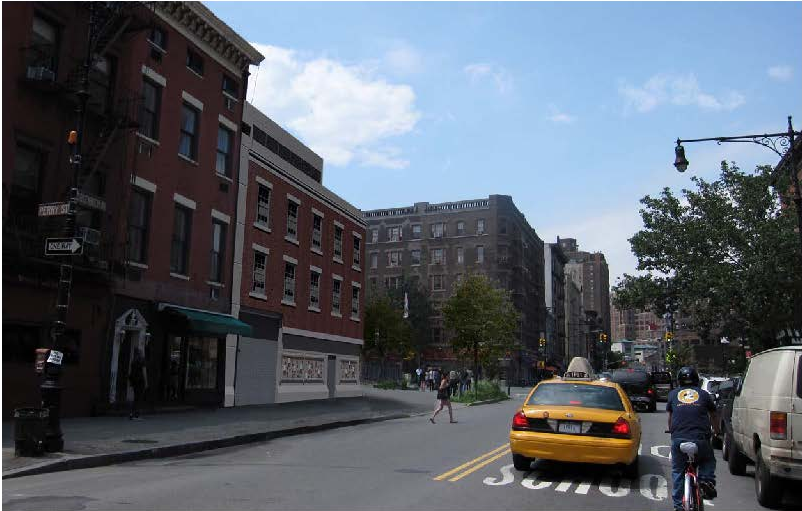Elected officials and residents urged MTA to refine design of subway ventilation building. On June 14, 2011, Landmarks issued a negative advisory report on the Metropolitan Transit Authority’s design for a proposed four-story ventilation plant at the intersection of Seventh Avenue South and Greenwich Avenue in the Greenwich Village Historic District. The building will provide emergency ventilation for the Seventh Avenue and IND subway lines. The triangular lot, known as Mulry Square, is the site of the “Tiles for America” 9/11 memorial featuring decorated ceramic tiles hung from the chain-link fence that surrounds the unimproved lot.
Judith Kunoff, chief architect of MTA New York City Transit, described the challenges of designing a secure utilitarian structure that would also be aesthetically suitable for the historic district. MTA planned to attach cast-brick “overlay screens” six inches in front of the concrete-clad, windowless building. The brick overlays would attempt to mimic the 19th-century Greek- Revival rowhouses common in the district. The concrete walls would be visible through the “windows” of the overlays and at the points where the overlays attach to the building. The set back fourth story would not be masked with the brick screen. The windows would be subtly illuminated at night. The Tiles for America memorial would be preserved and secured to a chain link fence attached to the building’s first floor.
Residents, preservationists, and elected officials criticized the proposal. Representatives of Congressman Jerrold Nadler, Manhattan Borough President Scott M. Stringer, Council Speaker Christine C. Quinn, State Senator Thomas K. Duane, and Assembly Member Deborah Glick urged the MTA to reconsider the plan. Quinn’s representative stated that the building should feature a continuous facade and incorporate additional design elements to better highlight the 9/11 memorial. In his submitted testimony, Duane stated that it would be “an affront” to everyone who has worked to preserve the Greenwich Village Historic District if the MTA did not modify the plan to better integrate the facility with the area’s residential and commercial uses.
Doris Diether, representing Manhattan Community Board 2, criticized the proposed window pattern and argued that the MTA should reduce the building’s height to maintain a consistent cornice line with adjacent rowhouses. The Greenwich Village Society for Historic Preservation’s Elizabeth Finkelstein called the proposed structure “an overly complicated and awkward hybrid.”
The Commissioners also criticized the proposal. Commissioner Fred Bland stated that the plan was “patronizing to what the Village is about” and likened the use of the faux historic screens to “hiding behind a fig leaf.” Commissioner Joan Gerner believed that a more utilitarian approach would be appropriate. Commissioner Christopher Moore believed that the proposal was the product of “a lot of thought and good intentions,” but ultimately inadequate for the site. Commissioner Michael Goldblum claimed that the plan for the Tiles of America exhibit was “too incidental” and could be better integrated into the design.
Because the property is owned by a State agency, Landmarks could only issue a non-binding advisory report on the MTA’s proposal. Chair Robert B. Tierney credited the MTA for attempting to design an appropriate structure for the district, but he agreed with the other Commissioners that the current proposal was inappropriate. Tierney stated that Landmarks would issue a report recommending that the MTA reconsider the use of the overlay screens and rethink how to preserve the memorial.
LPC: 61 Greenwich Ave., Manhattan (11-0180) (June 14, 2011) (Architect: MTA).


